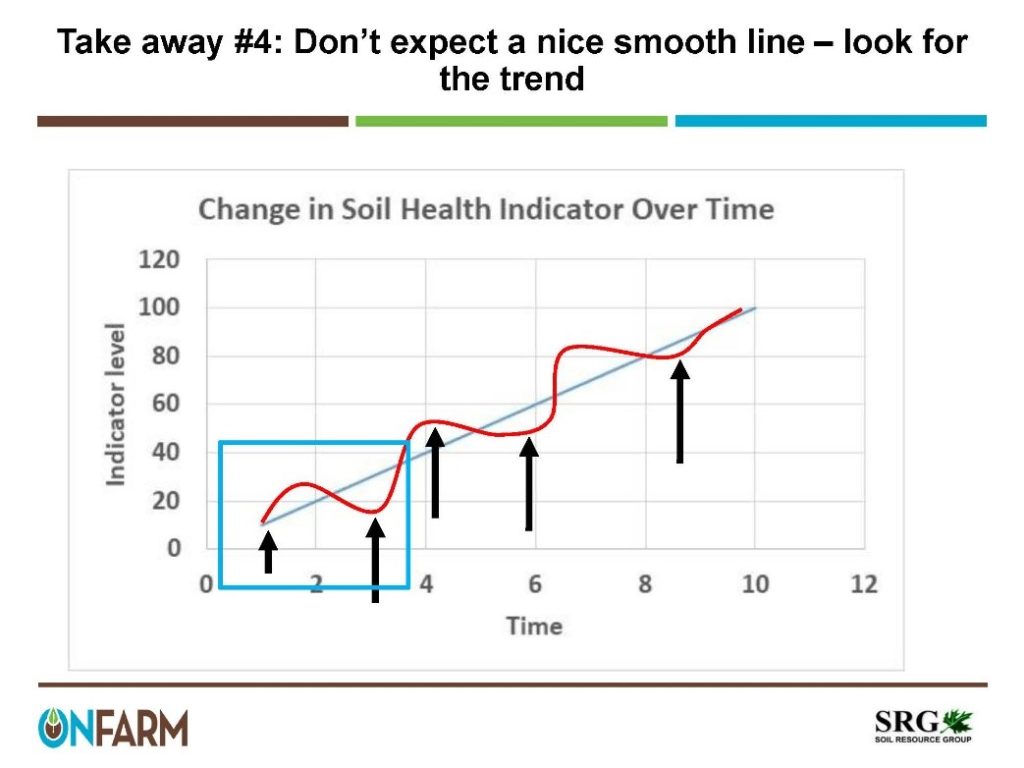By: Madeline Rodrigue, Programs Analyst, OSCIA
Many farmers recognize the importance of implementing best management practices (BMPs) to enhance soil health and sustainability. However, understanding the most effective ways to measure soil health and the long-term impact of different BMPs remains a challenge. In 2019, the On-Farm Applied Research and Monitoring (ONFARM) program was launched to investigate the effects of BMPs on soil health indicators and identify a suite of indicators that best represent soil health conditions in Ontario.
What sets the ONFARM program apart is its focus on real-world application. The program actively engaged farmers by establishing a network of cooperator sites on 25 working farms representative of different climates, soil conditions, and cropping systems across the province. While the program concentrated on three types of BMPs: cover crops, organic amendments, and reduced tillage, the trial designs were driven by the cooperating farmers’ own questions and plans. By involving farmers directly, the program ensures practicality and relevance in its research.
Comprehensive in-field and lab-based soil health assessments were conducted at benchmark locations across the treatments over three field seasons. In-field measurements encompassed parameters such as surface water infiltration, soil temperature, compaction, soil moisture, and bulk density. Laboratory analyses included soil organic matter (SOM), active carbon (AC), Solvita CO2, Solvita Labile Amino-Nitrogen (SLAN), potentially mineralizable nitrogen (PMN), and aggregate stability. Agronomic assessments were also conducted.
Identifying the most reliable soil health indicators (SHIs) to measure changes in soil health in response to BMP implementation proved to be a complex task. Correlations between SHIs, variability, and the responsiveness of each SHI to changes in SOM were examined. AC and SLAN appeared to be the most responsive to the BMPs at this early stage. Solvita CO2 respiration has been slower to respond to BMP treatments but showed less variability in its measurements. Solvita CO2 paired well with AC to better inform how carbon might be cycling in the soil. ACE soil protein shows promise as a relatively sensitive indicator but was only monitored in 2022 as a late addition to the testing package. While these are encouraging results, other indicators such as PMN, water infiltration, and nematode counts showed high variability. Indeed, counts of total and parasitic nematodes were found to be so variable both across sites, and within sampling points in each field, that the indicator was not tested again after the first year of monitoring.
The range in results also indicates that response of SHI can be influenced by site-specific details, such as soil degradation, inherent soil capabilities, soil type, and management history. It’s also important to recognize that trials were conducted over three field seasons (approximately one crop rotation cycle) which only allowed one or two BMPs to be implemented in some cropping systems; therefore, dramatic changes should not be expected. It’s clear that no single indicator can fully capture soil health conditions in Ontario. Continued monitoring over several years or crop rotations is recommended to enhance our understanding of indicator variability, and to identify a group of indicators that best reflect site-specific soil health conditions.

To be adopted by the broader farming community as routine measurements that can be usefully incorporated into management decisions, SHIs also need to be practical and affordable. A producer’s SHI sampling program should incorporate practices aimed at minimizing the impacts of the sources of variability discussed above, including:
- Identify benchmark locations in the field and go back to these same locations at each sampling event.
- Take composite samples from around that benchmark. A soil probe is recommended to get a consistent depth and volume of sample.
- Take separate samples from different landscape positions, or degraded areas etc., to track differential BMP impacts.
- Consider including a reference location that is not likely to change (e.g., fence row, pasture etc.) as a location that can be used to look for year to year changes.
- When comparing treatment effects, include a check strip.
- Sample either in late spring (June) or early fall (late September). Decide which suits your work schedule best – but then always take your samples during that same period.
- Know your lab: what SHI tests do they do? Consider cost and convenience. Aim to use the same lab for each sampling event.
- Be consistent – same sampling location, same time of year, same lab.
- Be patient and persistent – change will come, but expect variability along the way and don’t be discouraged by it.
ONFARM represents a significant step forward in understanding the impact of BMPs on soil health indicators in Ontario. By conducting on-farm trials and involving farmers directly, the program ensures that the research is practical and relevant to Ontario farmers. While short-term impacts of BMPs on soil health were observed, the program recognizes the need for long-term monitoring to assess the reliability of these changes over multiple crop rotations. Ongoing research is necessary to identify a suite of indicators that best represent soil health conditions in Ontario; ONFARM’s soil health data has been contributed to the upcoming Soil Health and Assessment Planning Tool (SHAP) developed by the Ontario Ministry of Agriculture, Food, and Rural Affairs and University of Guelph researchers. SHAP will enable farmers to score their own soil health analysis, and better understand their soil’s quality relative to other samples taken across Ontario.
To gain a more thorough understanding of the research and its implications, interested readers are encouraged to explore the comprehensive technical reports available on the ONFARM website (https://www.osciaresearch.org/onfarm-applied-research/onfarm-reports/).
The ONFARM program was funded through the Canadian Agricultural Partnership, a five-year federal-provincial-territorial initiative. The success of this collaborative effort demonstrates the value of ongoing partnerships and cooperation among government, researchers, and farmers in support of soil health research.
For more information about the ONFARM program, please contact ONFARM@ontariosoilcrop.org.